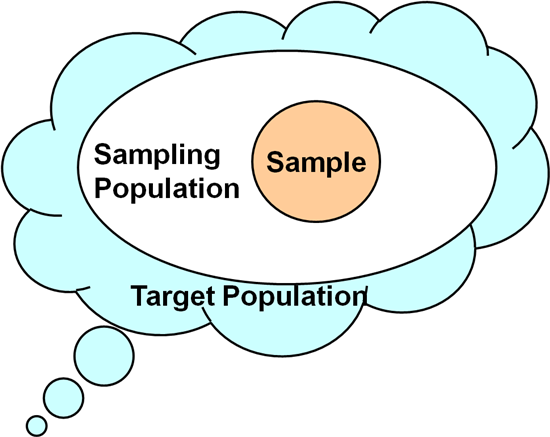Concepts in sampling
In order to end up with a representative sample of sufficient size to perform the study, we need to define several elements:
Contents
What is the sampling unit?
This is the smallest element of the sampling population in which we will make the study's observations. Usually, this is an individual person; the observations we make by questionnaires or interviews targeted at individual members of the study population. However, it could be a household, a school, or even entire towns or cities.
For example, if we want to study the relationship between religion and vaccine coverage, this would be done by studying "the population of towns in the country" and measuring the distribution (proportions) of various religions and vaccine coverage within each town.
What is the sampling fraction?
This is the proportion of the target population that is included in the sample. For example, if the total size of the target population that we want to study is 100.000 people, and in the sample, we include 500, then the sampling fraction is 0.5%
What is the sampling frame?
In the ideal situation, we have a comprehensive and exhaustive registry of all units of our population. Such complete population registers at the national level make it possible to draw samples directly from this registry, according to our preferred scheme.
However, what do we do if such a system does not exist? What if we cannot know each individual in the population? Then we go looking for the best list of registered units that we believe is representative of the whole population. When we have such a list of all the sampling units from which the sample is drawn, then such a list is the sampling frame. For example, we can have a list of all children < 5 years of age, or of all households in a province, or of all health care units in a district.
Which sampling scheme to use?
There are different methods (sampling schemes) of selecting sampling units from the sampling frame, for example:
- Simple random sampling
- Systematic sampling
- Stratified sampling
- Probability proportional to size sampling
- Cluster sampling
- Quota sampling
- Convenience sampling or Accidental Sampling
- Line-intercept sampling
- Panel sampling
<<<THIS CHAPTER REQUIRES COMPLETION AND FINDING A DEDICATED EDITOR. INTERESTED? Write below !>>
FEM PAGE CONTRIBUTORS 2007
- Editor
- Arnold Bosman
